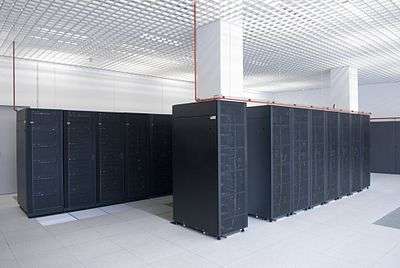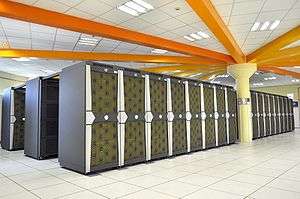Supercomputing in Europe
Several centers for supercomputing exist across Europe, and distributed access to them is coordinated by European initiatives to facilitate high-performance computing. One such initiative, the HPC Europa project, fits within the Distributed European Infrastructure for Supercomputing Applications (DEISA), which was formed in 2002 as a consortium of eleven supercomputing centers from seven European countries. Operating within the CORDIS framework, HPC Europa aims to provide access to supercomputers across Europe.[1]
In June 2011, France's Tera 100 was certified the fastest supercomputer in Europe, and ranked 9th in the world at the time.[2][3][4][5] It was the first petascale supercomputer designed and built in Europe.[6]
Since November 2013, Switzerland's Piz Daint is the fastest European supercomputer and is currently ranking 6th in the world with a peak of 7,789 TFlops.[7][8]
Belgium
On October 25, 2012, Ghent University (Belgium) inaugurated the first Tier 1 supercomputer of the Flemish Supercomputer Centre (VSC). The supercomputer[9] is part of an initiative by the Flemish government to provide the researchers in Flanders with a very powerful computing infrastructure. The new cluster is ranked 163rd in the worldwide Top500 list of supercomputers (edition November 2012).
Bulgaria
The National Center for Supercomputing Applications in Sofia operates an IBM Blue Gene/P supercomputer, which offers high-performance processing to the Bulgarian Academy of Sciences and Sofia University, among other organizations.[10] This system is one of the few supercomputers in Eastern Europe, and the only one in the Balkans. The system was on the TOP500 list until November 2009, when it ranked as number 379.[11]
Finland
CSC - IT Center for Science is operating a Cray XC30 system with 244TFlop/s, which is assumed to be scaled up to PFlop/s range in 2014.[12]
France
The Commissariat à l'énergie atomique et aux énergies alternatives (CEA) operates the Tera 100 machine in the Research and Technology Computing Center in Essonne, Île-de-France.[2] The Tera 100 has a peak processing speed of 1,050 teraflops, making it the fastest supercomputer in Europe as of 2011.[13] Built by Groupe Bull, it has 140,000 processors.[14]
The National Computer Center of Higher Education (French acronym: CINES) was established in Montpellier in 1999, and offers computer services for research and higher education.[15][16] It operates the Jade SGI Altix system, which has a peak processing speed of 237 teraflops, and is the third-fastest supercomputer in France, the second-fastest being a commercial system operated by a French manufacturing company.
Germany
In Germany, supercomputing is organized at two levels. The three national centers at Garching (LRZ), Juelich (JSC) and Stuttgart (HLRS) together form the Gauss Center for Supercomputing, and provide both the European Tier 0 level of HPC and the German national Tier 1 level. A number of medium-sized centers are also organized in the Gauss Alliance.
The Jülich Supercomputing Centre (JSC) and the Gauss Centre for Supercomputing jointly own the JUGENE computer at the Forschungszentrum Jülich in North Rhine-Westphalia. JUGENE is based on IBM's Blue Gene/P architecture, and in June 2011 was ranked the 12th-fastest computer in the world by TOP500.[17] It has been replaced by the Blue Gene/Q system JUQUEEN on 31 July 2012.[18] The Leibniz-Rechenzentrum, a supercomputing center in Munich, houses the SuperMUC system, which began operations in 2012 at a processing speed of 3 petaflops. This was, at the time it entered service, the fastest supercomputer in Europe. The High Performance Computing Center in Stuttgart fastest computing system is Hazel Hen with a peak performance of more than 7,4 petaflops. Hazel Hen is based on Cray XC40 technology and was ranked the 8th fastest system of the world in the November 2015 TOP500 List.[19]
Ireland
The Irish Centre for High-End Computing (ICHEC) is the national supercomputing centre and operates the Fionn[20] supercomputer, a heterogeneous system whose core partition consists of a 7,680-processor SGI ICE X cluster providing 147 TFlops of computing power and 20 TB of memory. Fionn also contains nodes with many-core technology from Intel (Xeon Phi coprocessors) and Nvidia (Tesla GPGPU cards), as well as a SGI UV partition with 112 processors and 1.7 TB of shared memory.
Italy
The main supercomputing institution in Italy is CINECA, a consortium of many universities and research institutions scattered throughout the country. A supercomputer called FERMI, based on IBM's BlueGene/Q architecture was commissioned in spring 2012, and was due to be fully operational by August 2012. FERMI will be the fastest supercomputer in Italy with a peak performance of 2.1 PFLOPS, making it one of the fastest supercomputers in Europe.[21]
Due to the involvement of the National Institute for Nuclear Physics (INFN) in the main experiments taking place at CERN, Italy also hosts some of the largest nodes of the Worldwide LHC Computing Grid, including one Tier 1 facility and 11 Tier 2 facilities out of 151 total nodes.[22][23]
Netherlands
The European Grid Infrastructure, a continent-wide distributed computing system, is headquartered at the Science Park in Amsterdam.[24]
Norway
The Norwegian University of Science and Technology (NTNU) in Trondheim operates the "Vilje"-supercomputer, owned by NTNU and the Norwegian Meteorological Institute. "Vilje" is operating at 275 teraflops.[25]
University of Oslo operates "Abel"-supercomputer named after the famous Norwegian mathematician Niels Henrik Abel (1802 – 1829), owned by UiO. "Abel" is operating at 258 terraflops and reached position 96 in the top500 list in 2012 when it was installed.
Poland
The Polish Grid Infrastructure PL-Grid was built between 2009 and 2011 as a nationwide computing infrastructure, and will remain within the PLGrid Plus project until 2014. At the end of 2012, it provided 230 teraflops of computing power and 3,600 terabytes of storage for the Polish scientific community.
The Galera computer cluster at the Gdansk University of Technology was ranked 299th on the TOP500 list in November 2010.[26][27] The Zeus computer cluster at the ACK Cyfronet AGH in Kraków was ranked 106th on the TOP500 list in November 2012.[28]
Russia
In November 2011, the 33,072-processor Lomonosov supercomputer in Moscow was ranked the 18th-fastest supercomputer in the world, and the third-fastest in Europe.[19] The system was designed by T-Platforms, and used Xeon 2.93 GHz processors, Nvidia 2070 GPUs, and an Infiniband interconnect.[19]
In July 2011, the Russian government announced a plan to focus on constructing larger supercomputers by 2020.[29] In September 2011, T-Platforms stated that it would deliver a water-cooled supercomputer in 2013.[30]
Slovenia
The Slovenian National Grid Initiative (NGI) provides resources to the European Grid Initiative (EGI). It is represented in the EGI Council by ARNES. ARNES manages a cluster for testing computing technology where users can also submit jobs. The cluster consists of 2300 cores and is growing.[31] Arctur also provides compute resources on its Arctur-1 supercomputer to the Slovenian NGI.
"Jožef Stefan" Institute has in summary most of the HPC installations in Slovenia. They are not however a single uniform HPC system, but several dispersed systems at separate research departments (F-1,[32] F-9[33] and R-4[34]).
Spain

The Barcelona Supercomputing Center is located at the Technical University of Catalonia and was established in 2005.[35] The center operates the 1-petaflop MareNostrum supercomputer and other supercomputing facilities. The Supercomputing and Visualization Center of Madrid (CeSViMa) at the Technical University of Madrid operates the 72-teraflop Magerit supercomputer, which uses 86 IBM BladeCenters. The Spanish Supercomputing Network furthermore provides access to several supercomputers distributed across Spain.
Sweden
The National Supercomputer Centre in Sweden (NSC) is located in Linköping and operates the Triolith supercomputer which achieved 407.2 Teraflop/s on the Linpack benchmark which rendered it place 79 on the November 2013 issue of the Top500 list of the fastest supercomputers in the world.[36]
Sweden's Royal Institute of Technology operates the Beskow supercomputer, which consists of 53,632 processors and has achieved sustained 1.397 Petaflops/s.[37]
Switzerland
The Swiss National Supercomputing Centre was founded in 1991 and is operated by ETH Zurich. It is based in Lugano, Ticino, and provides supercomputing services to national research institutions and Swiss universities, as well as the international CERN organisation and MeteoSchweiz, the Swiss weather service.[38] In February 2011, the center placed an order for a Cray XMT massively parallel supercomputer.[39]
The IBM Aquasar supercomputer became operational at ETH Zurich in 2010. It uses hot water cooling to achieve heat efficiency, with the computation-heated water used to heat the buildings of the university campus.[40][41]
United Kingdom
The EPCC supercomputer center was established at the University of Edinburgh in 1990.[42] The HECToR project at the University of Edinburgh provided supercomputing services using a 360-teraflop Cray XE6 system, the fastest supercomputer in the UK.[43] In 2013, HECToR was replaced by ARCHER, a Cray XC30 system.[44] The European Centre for Medium-Range Weather Forecasts (ECMWF) in Reading, Berkshire, operates a 100-teraflop IBM pSeries-based system.
See also
- Distributed computing
- History of supercomputing
- Quasi-opportunistic supercomputing
- Science and technology in Europe
- Supercomputer architecture
- Supercomputing in China
- Supercomputing in India
- Supercomputing in Japan
- Supercomputing in Pakistan
References
- ↑ Grid middleware and services: challenges and solutions. Domenico Talia (2008). ISBN 0-387-78445-4. Pages 109-110.
- 1 2 High performance computing at CEA. CEA – HPC. Retrieved 10 October 2012.
- ↑ "Tera 100 is Europe’s Most Powerful Supercomputer". Inside HPC. June 21, 2011. Retrieved January 10, 2013.
- ↑ TOP500 list
- ↑ CNN Money.
- ↑ Bloomberg.
- ↑ TOP500 list November 2013 Retrieved August 4, 2015.
- ↑ TOP500 list June 2015 Retrieved August 4, 2015.
- ↑ Website of VSC
- ↑ Bulgaria PM Opens National Supercomputer Research Center. Novinite.com. 9 September 2008.
- ↑ Bulgarian State Agency for Information Technology and Communications (SAITC), Blue Gene/P solution
- ↑ "Sisu now in production". News release. CSC - IT Center for Science. 18 March 2013. Retrieved 15 March 2014.
- ↑ HPC. 21 June 2011.
- ↑ PC World. May 28, 2010.
- ↑ CINES website.
- ↑ Advances in Computers: Computer Performance Issues. Marvin V. Zelkowitz (2009). ISBN 0-12-374810-0. p.79.
- ↑ Physorg May 26, 2009
- ↑ http://www.fz-juelich.de/SharedDocs/Meldungen/IAS/JSC/EN/2012/2012-04-juqueen.html
- 1 2 3 TOP500 report. November 2015. Retrieved 2016-07-15.
- ↑ Fionn supercomputer at ICHEC. Retrieved 2014-09-19.
- ↑ "CINECA - HPC portal". Retrieved 17 March 2012.
- ↑ "Tier sites of the Worldwide LHC Computing Grid.". Retrieved 17 March 2012.
- ↑ "Topology of the Worldwide LHC Computing Grid". Retrieved 17 March 2012.
- ↑ "European Grid Initiative Head Office comes to Science Park Amsterdam". News release. University of Amsterdam. 23 March 2009. Retrieved 17 October 2011.
- ↑ "NTNU får Norges kraftigste superdatamaskin". News release. Norwegian University of Science and Technology. 24 June 2011. Retrieved 16 January 2013.
- ↑ TOP500 Galera
- ↑ EE Times Europe April 21, 2008 Poland's supercomputer among Europe's top 10.
- ↑ TOP500 Zeus
- ↑ ComputerWorld. 25 July 2011.
- ↑ HPCWire. 29 September 2011. Retrieved 2012-02-05.
- ↑ National Grid Initiatives (NGIs). DCNet. Retrieved 10 October 2012.
- ↑ F-1 Computing grid
- ↑ SiGNET Strojna oprema
- ↑ R-4 Computer clusters Krn and Mangrt)
- ↑ http://www.bsc.es/ibm-bsc
- ↑ National Supercomputer Centre in Sweden. 17 February 2014.
- ↑
- ↑ ETH Zurich
- ↑ Marketwire. February 18, 2011.
- ↑ HPC Wire, 2 July 2010.
- ↑ CNet, 10 May 2010.
- ↑ EPCC History.
- ↑ Inside the UK's fastest machine. James Randerson. The Guardian. 2 January 2008.
- ↑ About ARCHER
